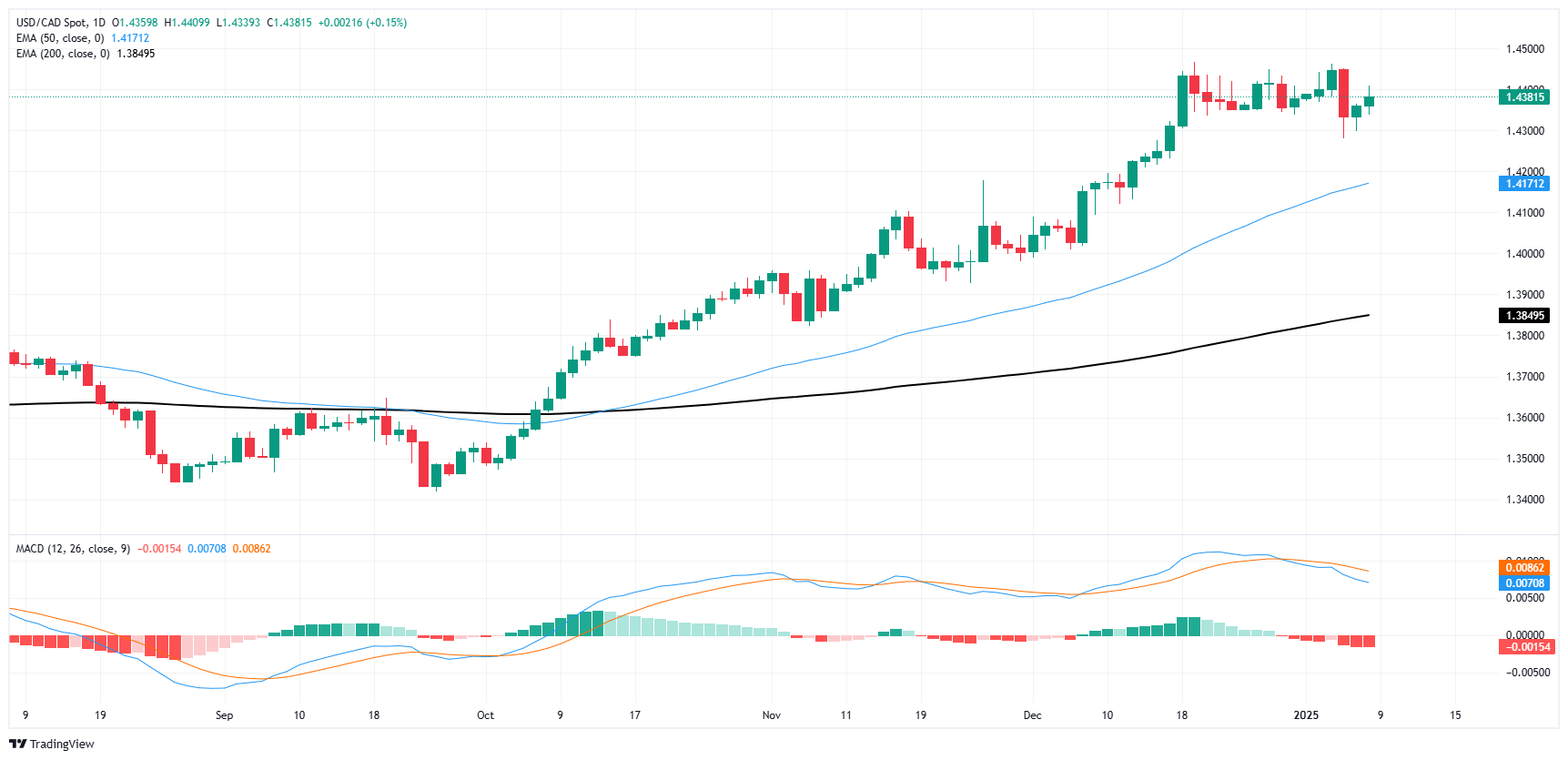Canadian Dollar continues to pare recent gains, falls back further on Wednesday.

- The Canadian Dollar shed another 0.2% on Wednesday as the Loonie shrivels.
- Canada saw a data-light day on the calendar, market flows continue to tilt toward the Greenback.
- US jobs data cooled, keeping investor sentiment tepid.
The Canadian Dollar (CAD) shed another one-fifth of one percent on Wednesday as the Loonie continues to flub chances for a technical recovery from multi-year lows against the US Dollar. CAD flows remains subdued, and the Loonie is backsliding into near-term congestion against the Greenback.
Canada was largely absent from the economic data docket on Wednesday as markets broadly focus on US jobs data, with the ADP Employment Change for December easing more than expected in December and serving as a tepid preview of Friday’s upcoming US Nonfarm Payrolls (NFP) report.
Daily digest market movers: US jobs data bodes poorly for the Loonie as risk sentiment weighs
- A clear lack of Canadian economic data keeps market flows decidedly in the Greenback’s court.
- US ADP job gains shrank to 122K in December, below the expected 140K. Slowing US jobs growth could put a hamper on investor sentiment as signs of economic softening risk blowing past rate cutting territory directly into the recession zone.
- The Fed’s latest Meeting Minutes revealed Fed policymakers are pumping the brakes on further rate cuts due in no small part to incoming US President Donald Trump’s plans to unilaterally apply steep tariffs to all of the US’ main allies and trading partners in an effort to fund his scattershot government policy plans.
- In the face of a volatile new chapter in US-Canadian relations, Canadian Prime Minister Justin Trudeau has vacated his position, leaving Canadian parliament prorogued until the end of March as Canadian politicians select a new leader from the Canadian Liberal Party.
- Canadian employment and labor figures are due on Friday, but market reactions will be eclipsed by the US’ latest Nonfarm Payrolls (NFP) jobs data dump.
Canadian Dollar price forecast
The Canadian Dollar (CAD) continues to recede against the US Dollar as Loonie traders struggle to find reasons to hit the buy button. USD/CAD has been caught in rough sideways churn since the Loonie fell to multi-year lows against the Greenback in mid-December, bolstering the USD/CAD pair to its highest bids since the pandemic.
Despite a near-term freeze in momentum, the pair is still leaning firmly into bull country, though buyers are struggling to finish the journey to the 1.4500 handle. The 1.4400 level is proving to be the barrier to beat, and Loonie bidders could force the pair back down to the 50-day Exponential Moving Average (EMA) which is rising into 1.4200.
USD/CAD daily chart
Canadian Dollar FAQs
The key factors driving the Canadian Dollar (CAD) are the level of interest rates set by the Bank of Canada (BoC), the price of Oil, Canada’s largest export, the health of its economy, inflation and the Trade Balance, which is the difference between the value of Canada’s exports versus its imports. Other factors include market sentiment – whether investors are taking on more risky assets (risk-on) or seeking safe-havens (risk-off) – with risk-on being CAD-positive. As its largest trading partner, the health of the US economy is also a key factor influencing the Canadian Dollar.
The Bank of Canada (BoC) has a significant influence on the Canadian Dollar by setting the level of interest rates that banks can lend to one another. This influences the level of interest rates for everyone. The main goal of the BoC is to maintain inflation at 1-3% by adjusting interest rates up or down. Relatively higher interest rates tend to be positive for the CAD. The Bank of Canada can also use quantitative easing and tightening to influence credit conditions, with the former CAD-negative and the latter CAD-positive.
The price of Oil is a key factor impacting the value of the Canadian Dollar. Petroleum is Canada’s biggest export, so Oil price tends to have an immediate impact on the CAD value. Generally, if Oil price rises CAD also goes up, as aggregate demand for the currency increases. The opposite is the case if the price of Oil falls. Higher Oil prices also tend to result in a greater likelihood of a positive Trade Balance, which is also supportive of the CAD.
While inflation had always traditionally been thought of as a negative factor for a currency since it lowers the value of money, the opposite has actually been the case in modern times with the relaxation of cross-border capital controls. Higher inflation tends to lead central banks to put up interest rates which attracts more capital inflows from global investors seeking a lucrative place to keep their money. This increases demand for the local currency, which in Canada’s case is the Canadian Dollar.
Macroeconomic data releases gauge the health of the economy and can have an impact on the Canadian Dollar. Indicators such as GDP, Manufacturing and Services PMIs, employment, and consumer sentiment surveys can all influence the direction of the CAD. A strong economy is good for the Canadian Dollar. Not only does it attract more foreign investment but it may encourage the Bank of Canada to put up interest rates, leading to a stronger currency. If economic data is weak, however, the CAD is likely to fall.
Information on these pages contains forward-looking statements that involve risks and uncertainties. Markets and instruments profiled on this page are for informational purposes only and should not in any way come across as a recommendation to buy or sell in these assets. You should do your own thorough research before making any investment decisions. FXStreet does not in any way guarantee that this information is free from mistakes, errors, or material misstatements. It also does not guarantee that this information is of a timely nature. Investing in Open Markets involves a great deal of risk, including the loss of all or a portion of your investment, as well as emotional distress. All risks, losses and costs associated with investing, including total loss of principal, are your responsibility. The views and opinions expressed in this article are those of the authors and do not necessarily reflect the official policy or position of FXStreet nor its advertisers. The author will not be held responsible for information that is found at the end of links posted on this page.
If not otherwise explicitly mentioned in the body of the article, at the time of writing, the author has no position in any stock mentioned in this article and no business relationship with any company mentioned. The author has not received compensation for writing this article, other than from FXStreet.
FXStreet and the author do not provide personalized recommendations. The author makes no representations as to the accuracy, completeness, or suitability of this information. FXStreet and the author will not be liable for any errors, omissions or any losses, injuries or damages arising from this information and its display or use. Errors and omissions excepted.
The author and FXStreet are not registered investment advisors and nothing in this article is intended to be investment advice.



